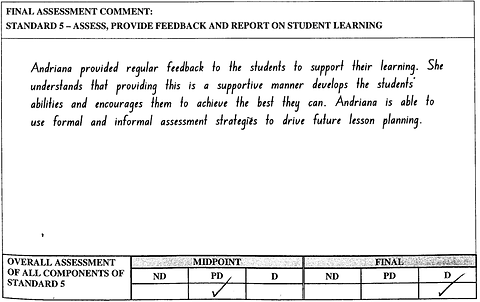
I'm a description. Click to edit me

I'm a description. Click to edit me


I'm a description. Click to edit me
Portfolio of Professional Practice
Standard 5
5.1.1- Demonstrate understanding of assessment strategies, including informal and formal, diagnostic, formative and summative approaches to assess learning.
Assessment is an integral component in teaching and learning experiences that enables the teacher to measure the degree of learning of students against the intended outcomes (Devitt, 2014). The Queensland Studies Authority (2014) states that assessment should be reasonable and equitable to meet the diverse needs of all students. As an early childhood and primary educator, I have explored various forms of assessments such as work samples, observations, anecdotal records, note taking and checklists. An anecdotal record, for example, was used in a preschool classroom, as I observed a student and documented word-for-word, what the student was doing and saying. The application of these formal and informal assessments recognises student achievement, is a part of planning, is a key professional tool, supports future teaching and learning experiences, and draws on how students learn (Department of Education, Training and Employment, 2014).
Formal and informal assessment strategies have enabled me to distinguish students' prior knowledge (diagnostic), monitor students' progress during a unit of work (formative), and also assess students level of achievement at the end of the unit (summative) (Department of Education, 2014). Using diagnostic assessment in a year one class for example, was implemented at the introduction of a lesson through activities such as a KWL chart and brainstorming. During this period, questions were asked to stimulate students thinking, such as "what might a car sound like?" By using diagnostic assessments such as these, the teacher is able to develop an awareness of what students already know and what students need to know more of (Department of Education, 2014). Formative assessment is conducted as a unit is being taught in the form of 'specific anecdotal observations or the collections of various work samples' (Devitt, 2014). In a year one classroom, I used work samples to grasp on students level of understandings, collect samples to distinguish their improvement in comparison to previous learning tasks, and as importantly, to become informed on how to develop future lessons. Summative assessment on the other hand could involve concept maps, problem solving activities and oral presentations (Northern Illinous University, n.d). For example, students in a year one class were assessed on their ability to collate information of any chosen animal on a collage, demonstrate their understandings and present it orally to the class.
Fundamentally, a range of informal and formal, formative, summative, and diagnostic assessments should be utilised for students to demonstrate their knowledge and skills, free from bias and misrepresentation (Department of Education, 2014).
The following evidence demonstrates my knowledge and practice of Standard 5:
The following link demonstrates a unit of work for Creative Arts, with an integration of formative, summative and diagnostic assessments: Creative Arts Unit of Work



The document on the left demonstrates an anecdotal record of two students in a play area.